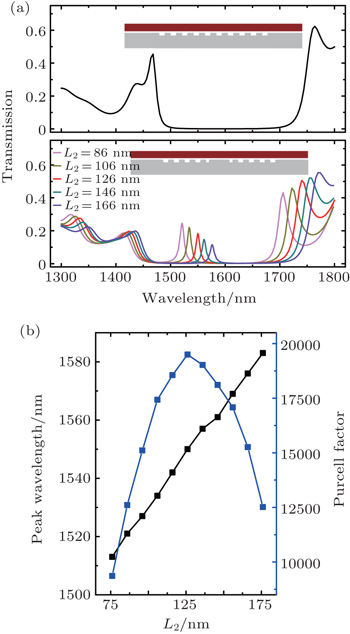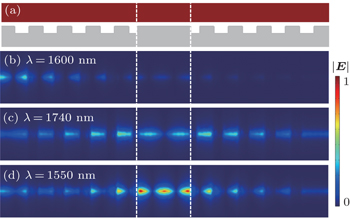† Corresponding author. E-mail:
‡ Corresponding author. E-mail:
Project supported by the National Key Basic Research Special Foundation of China (Grant Nos. 2012CB921501 and 2013CB632703) and the National Natural Science Foundation of China (Grant Nos. 11274160, 91221206, and 51271092).
Herein, we propose a high-quality (Q) factor hybrid plasmonic nanocavity based on distributed Bragg reflectors (DBRs) with low propagation loss and extremely strong mode confinement. This hybrid plasmonic nanocavity is composed of a high-index cylindrical nanowire separated from a metal surface possessing shallow DBRs gratings by a sufficiently thin low-index dielectric layer. The hybrid plasmonic nanocavity possesses advantages such as a high Purcell factor (Fp) of up to nearly 20000 and a gain threshold approaching 266 cm−1 at 1550 nm, promising a greater potential in deep sub-wavelength lasing applications.
Optical resonant cavities have attracted a great deal of attention because of their ability to manipulate optical energy in small volume and to consequently tailor light-matter interactions. This ability is of great importance, for it facilitates useful practical applications in designing optical filters, switches, low-threshold lasers, brighter single-photon sources, and so on.[1–9] Moreover, both confining the light in high-Q cavities to increase the lifetime of the optical excitation and reducing the effective mode volume (Veff) are crucial in the designs of the optical resonant cavities.[10]
Surface plasmon (SP) is the collective electron charge oscillations that exist at the interface between the metal and dielectric media. It is capable of producing highly enhanced optical fields below the diffraction limit, which yields great potential to confine and manipulate light at sub-wavelength scale with a reduced Veff.[11] As a result, recently, plasmonic resonators have been presented widely in theory and experiment, including diverse metallic nanocavities making use of localized SP (LSP)[12–15] and surface plasmon polaritons (SPPs).[10,16] However, the Q factors of LSP resonators are limited because of radiation and metallic losses. Although the SPPs resonators exhibit higher Q factors compared to LSP resonators, the former also suffer from huge propagation loss. In order to reduce propagation loss while offering tight mode confinement at sub-wavelength scale, a hybrid plasmonic waveguide comprised of a high-index dielectric nanowire separated from a silver surface by a nanoscale low-index dielectric gap was proposed,[17] which appears to be helpful in improving the Q factors of SPPs resonators. Subsequently, a plasmon laser[18] based on this kind of hybrid plasmonic waveguide was successfully demonstrated, and the feedback mechanism of this nanometer-scale plasmonic laser is based on a Fabry–Perot cavity provided by reflection of the nanowire end-facets. Taking into account the low reflection of the nanowire end-facets, we hope to further improve the Q factors of cavities by introducing high-reflectivity DBRs,[10,16] while maintaining a small mode volume.
In this letter, we design a hybrid plasmonic nanocavity based on DBRs, with an ultra-small mode volume and a high Q factor. As an example, Purcell factor of up to nearly 20000 and low gain threshold are achieved at 1550 nm, which are preferred to enable highly efficient nanocavity feedback for the potential applications such as deep sub-wavelength scale lasing.
The proposed hybrid plasmonic nanocavity, as shown in Fig.
By controlling the hybridization of the fundamental guided mode of the 100 nm radius GaAs nanowire and the SPPs of the dielectric–metal interface at the telecommunication wavelength 1550 nm, we can simultaneously make sure tight mode confinement and single-mode propagation, as the dielectric gap width between the nanowire and the upper metal plane is set to g1 = 2 nm. The depth of the grooves are set as h = 25 nm, in other words, g2 = g1 + h = 27 nm. The center wavelength of the stop band is related to the mode effective refractive indices. The mode effective refractive indices are calculated and displayed graphically in Fig.
The optical properties of the hybrid plasmonic nanocavities are subsequently investigated. In order to evaluate the propagation performance of the DBR, the transmission of a DBR grating composed of 10 periods with periodicity P = 400 nm is simulated as plotted in the upper panel of Fig.
For example, when L2 = 126 nm, a hybrid plasmonic nanocavity with resonant wavelength at 1550 nm can be achieved. Here, we use the ratio of the center wavelength of the resonant peak (λc) and its full width at half maximum (FWHM) to define the Q factor of this hybrid plasmonic cavity mode (Q = λc/FWHM). In this case, the transmittance of sharp resonant is 18.3% at λc = 1550 nm and the corresponding FWHM is 8.3 nm, which leads to a high Q factor of 187 owing to the low propagation loss. Since the transmission and FWHM of the resonant peak in the hybrid plasmonic nanocavity depend upon the period number (N) of the DBRs, as N increases, the FWHM reduces accordingly.[20,21] As an example, when the N of each DBR is 7 and 10, the FWHM reduces to about 5.3 and 4.6 nm, yielding higher Q factors of up to 292 and 337, respectively. However, as N increases, the decrease of transmittance of the resonant peak will strongly limit the detection and its further application.[20,21] On the other hand, the mode volume of the proposed nanocavity can be calculated by


When L2 = 126 nm, an ultra-small mode volume of 3.04 × 10−22 m3 can be achieved for the hybrid plasmonic nanocavity with length L1 = 770 nm.
Based on an overall consideration of the effect of Q factor and Veff on the nanocavity, the Purcell factor is introduced to characterize the performance of the proposed nanocavity. Moreover, the Purcell factor is also a figure of merit to represent the ability of a cavity for spontaneous emission enhancement, which is described as[22]

To illustrate the mode profile of the DBRs-based nanocavity clearly, the simulated normalized electric field intensity of the nanocavity in the xy plane at different wavelengths are plotted in Fig.
Due to the large Purcell factor, which represents the fine ability of the hybrid plasmonic nanocavity for spontaneous emission enhancement that was demonstrated in plasmonic nanoparticle antennas,[23] we also demonstrate the utility of the hybrid plasmonic nanocavity to control emission properties of dipole for the optimized L2 = 176 nm at wavelength of 1550 nm. Figure
Considering the relatively high Q factor and ultra-small mode volume of the hybrid plasmonic nanocavity, we expect a low gain threshold for the lasing applications. To find out the gain threshold, a nanowire is chosen to be doped with optical gain material and we set the complex permittivity of the GaAs as 

We design a hybrid plasmonic nanocavity with high Q factor and ultra-small mode volume based on the DBRs and the hybrid plasmonic waveguide. The characteristics of Purcell factor of up to nearly 20000 and low gain threshold approaching 266 cm−1 at the telecommunication wavelength 1550 nm provide efficient cavity feedback and high lasing efficiency. This result shows significant potential for sub-wavelength lasing applications and development of nanoscale integrated photonic circuits
| 1 | |
| 2 | |
| 3 | |
| 4 | |
| 5 | |
| 6 | |
| 7 | |
| 8 | |
| 9 | |
| 10 | |
| 11 | |
| 12 | |
| 13 | |
| 14 | |
| 15 | |
| 16 | |
| 17 | |
| 18 | |
| 19 | |
| 20 | |
| 21 | |
| 22 | |
| 23 | |
| 24 |






